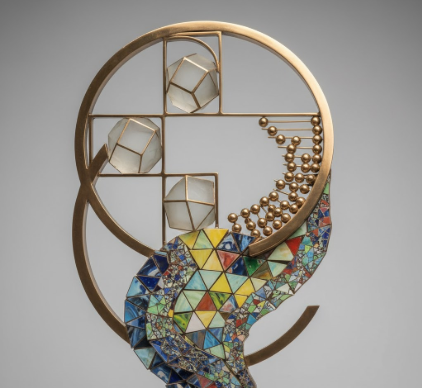At first glance, art and mathematics seem to inhabit entirely different worlds. One is the realm of emotion, creativity, and subjective beauty; the other is the world of logic, precision, and objective truth. Art is seen as fluid and expressive, while math is rigid and absolute. Yet, if you look closer, the line between them begins to blur. For centuries, these two disciplines have been engaged in a silent, elegant dance, influencing and enriching one another in ways that are both profound and visually stunning. The structure of a perfect composition, the harmony in a color palette, and the rhythm of a pattern all have roots in mathematical principles.
The Divine Proportion: Nature’s Aesthetic Code
Perhaps the most famous intersection of art and mathematics is the
Golden Ratio. It’s a special number, approximately 1.618, that has fascinated thinkers for millennia. Often represented by the Greek letter phi ($\phi$), this ratio appears with remarkable frequency in nature, from the spiral arrangement of seeds in a sunflower to the elegant curve of a nautilus shell. Ancient Greek architects and sculptors believed that this proportion was divinely inspired and key to creating visually pleasing forms. They incorporated it into the design of iconic structures like the Parthenon, ensuring its columns and facade had harmonious, balanced dimensions that resonated with the natural world.
Renaissance masters were equally obsessed with this mathematical key to beauty. Leonardo da Vinci, a genius in both art and science, extensively used the Golden Ratio in his work. His famous drawing, the
Vitruvian Man, is a study of human proportions based on the principles outlined by the Roman architect Vitruvius, which are closely linked to the Golden Ratio. Even the Mona Lisa is said to contain numerous instances of the Golden Rectangle, a shape whose sides are in the Golden Ratio, framing her face and body to create a composition that is inherently satisfying to the human eye.
The Golden Ratio is an irrational number, meaning its decimal representation never ends and never repeats. It is derived when a line is divided into two parts so that the ratio of the whole length to the longer part is the same as the ratio of the longer part to the shorter part. This unique mathematical property has led many to refer to it as the “divine proportion,” believing it to be a fundamental building block of beauty in the universe.
Crafting Illusion: The Geometry of Perspective
Before the Renaissance, paintings often looked flat and lacked a sense of depth. Figures in the background were sometimes the same size as those in the foreground, creating a disjointed and unrealistic scene. This all changed with the mathematical formalization of
linear perspective. Artists like Filippo Brunelleschi and Leon Battista Alberti used geometry to create a convincing illusion of three-dimensional space on a two-dimensional canvas.
The Vanishing Point
The core concept of linear perspective is simple yet revolutionary. It relies on the idea that parallel lines, like the sides of a road, appear to converge at a single point on the horizon, known as the vanishing point. By organizing the elements of a painting along these converging lines (orthogonals), artists could create a powerful sense of depth and distance. Suddenly, buildings receded into the background, floors appeared to stretch out before the viewer, and figures occupied a believable, structured space. Raphael’s masterpiece, “The School of Athens,” is a perfect example of one-point perspective, with all the architectural lines rushing towards a central vanishing point, drawing the viewer’s eye directly to the central figures of Plato and Aristotle.
Symmetry, Patterns, and the Beauty of Repetition
Symmetry is another principle shared by both mathematicians and artists. In mathematics, symmetry refers to an object being unchanged after a transformation, such as reflection, rotation, or translation. In art, symmetry is a powerful tool for creating balance, harmony, and a sense of order. From the bilateral symmetry of the human face to the radial symmetry of a rose window in a Gothic cathedral, these balanced arrangements are inherently pleasing to us.
This love for patterns is perhaps most beautifully expressed in Islamic art. Due to religious prohibitions on depicting animate beings, artists developed an incredibly sophisticated form of geometric art based on repeating patterns known as
tessellations. A tessellation is the tiling of a plane using one or more geometric shapes, with no overlaps and no gaps. Islamic artists created breathtakingly complex star and polygon patterns to adorn mosques and palaces, turning mathematics into a form of spiritual devotion. This work predated the mathematical study of these patterns in the West by centuries. Later, the Dutch artist M.C. Escher became famous for his mind-bending tessellations, where he transformed geometric shapes like triangles and squares into interlocking birds, fish, and lizards, explicitly demonstrating the artistic potential of pure mathematical concepts.
The Modern Dance: Fractals and Digital Art
The connection between art and math is not just a historical footnote; it continues to evolve. With the advent of computers, a new mathematical landscape opened up:
fractal geometry. A fractal is a never-ending pattern that is self-similar across different scales. Think of a fern, where each frond is a miniature version of the entire leaf, which is in turn made up of even smaller, similar fronds. These complex, infinitely detailed patterns are the visual representation of mathematical equations.
Artists and programmers now use fractal-generating software to create stunningly intricate digital artworks that seem both organic and otherworldly. These images bridge the gap between human creativity and computational logic. Interestingly, mathematicians have even used fractal analysis to study art. The chaotic, paint-splattered canvases of Jackson Pollock, for instance, have been shown to contain a fractal dimension, suggesting an underlying mathematical order within his seemingly random process. This shows that the bond between the two fields is a two-way street, where art can reveal mathematical structures just as math can provide tools for creating art.









